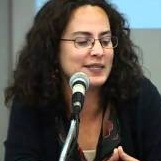Michelle Stefano, folklorist in residence for UMBC’s department of American studies, coordinates the Maryland Traditions program for the Maryland State Arts Council.
 What are the impacts of post-industrial change at the community level? Whether industrial landscapes – the temples to the long-standing and once thriving US manufacturing enterprise – are re-purposed or destroyed, what lives on in the hearts and minds of those who knew them best?
What are the impacts of post-industrial change at the community level? Whether industrial landscapes – the temples to the long-standing and once thriving US manufacturing enterprise – are re-purposed or destroyed, what lives on in the hearts and minds of those who knew them best?
The decline, dismantling, and disappearance of the many industries across the US deeply affects the towns, cities, and regions in which they were situated and the local communities with which they were intimately related. I believe understanding the effects of these post-industrial transitions, especially with respect to the relationships between community and place in both historical and contemporary contexts, is key to ensuring economically, environmentally, and culturally sustainable futures for American communities.
Nonetheless, when we hear about these stories of plants, mills and factories closing, it is often through the language of economics; statistics reflecting jobs lost, the rise in unemployment and the crumbling of local businesses tend to mask the more personal, or human, elements of such change. In this light, the panel, What Remains? Baltimore Neighborhoods in Transition (Thursday 9/19, 4:30 p.m., Albin O. Kuhn Library Gallery) seeks to spotlight the stories and memories – the intangible remnants of post-industrialization – of the communities of two historically interrelated and, yet, geographically separate areas: Baybrook, a group of six ethnically and racially diverse industrial neighborhoods in the southern peninsula of Baltimore City and the Sparrows Point Steel Mill area of Dundalk, situated just across the southwestern city border in Baltimore County. The lives of hundreds of thousands of Baltimore area residents (and beyond) have been shaped by these industrial centers, and the significance of them – from the personal and shared perspectives of those who knew them best – does not disappear as quickly.
Panel participants are both UMBC researchers and members of the Baybrook and Sparrows Point Steel Mill communities. Deborah Rudacille (English), who grew up in Dundalk, will reflect on the changes she has seen in the Sparrows Point area, drawing also from her oral history research for the book, Roots of Steel: Boom and Bust in an American Mill Town. Steve Bradley (Visual Arts) and Nicole King (American Studies) will discuss their work in Baybrook, funded in part through the BreakingGround initiative, focusing on the mapping of places of both historical and contemporary importance, as well as the stories and memories associated with them. Bill Shewbridge (Media and Communication Studies/the New Media Studio) and I will highlight our work in the Sparrows Point area, Mill Stories, a collection of digital stories that aim to amplify the voices, experiences, and importance of the Mill to a wider public. Community members include Jason Reed, who is involved with environmental justice projects in Baybrook, and Troy Pritt and Eddie Bartee, who worked at Sparrows Point for numerous years. Eddie is a third generation Sparrows Point steelworker who grew up in the company town, which was situated in the middle of the Mill complex and was razed in the 1970s. Denise Meringolo (History), whose research has focused on community-based public history practice, particularly in Baltimore, will moderate the discussion.
Contact the author, Michele Stefano, at ms@umbc.edu.



Leave a comment